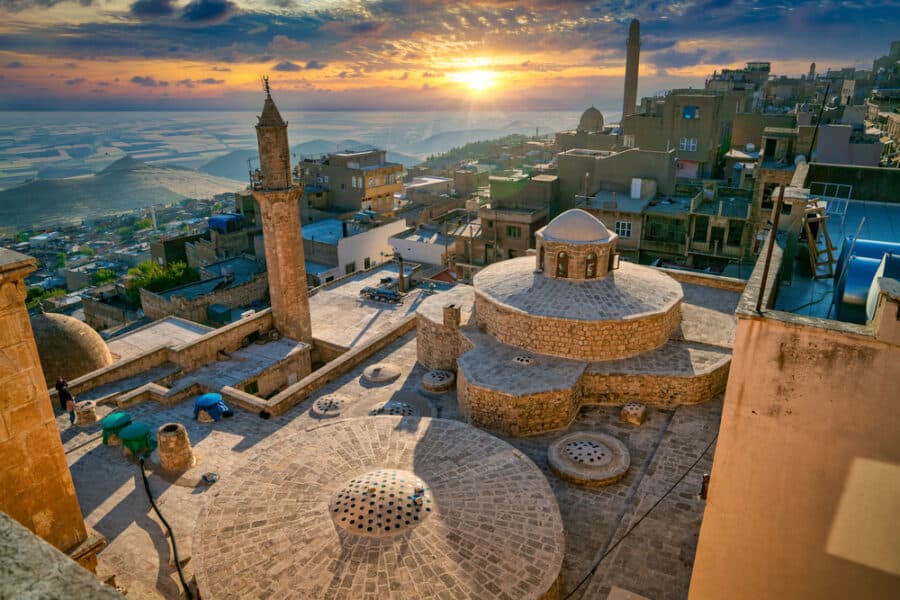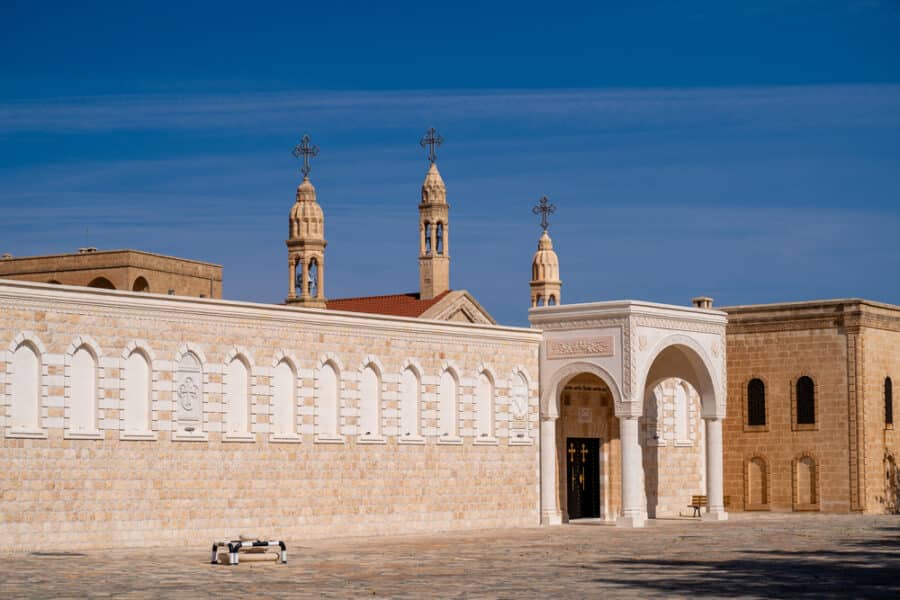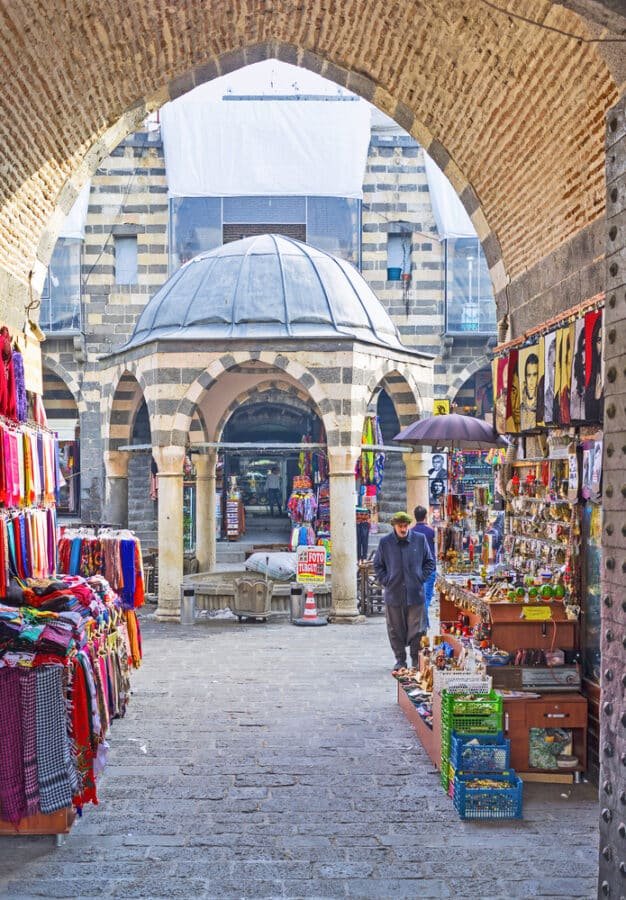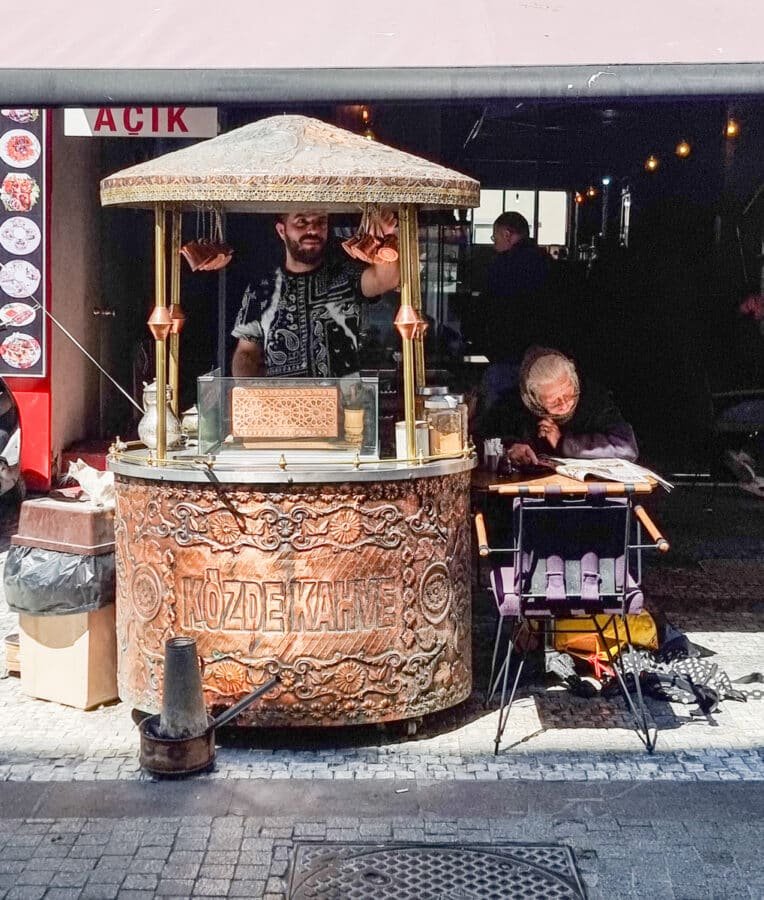Everyone knows that Turkey is definitely worth a visit. You only have to read this blog to know that! As you read, you’ll also see that it’s a very historical and cultural country to visit, and there is more history to explore here than you can even imagine.
However, many people tend to overlook the southeast part of the country. That’s probably because, for many years, it was considered “risky”. After all, it was closer to the Syrian border than the rest of the country.
However, with a little careful planning, this beautiful and ancient part of Turkey is safer than it’s ever been.

Southeastern Turkey is somewhere you will never regret visiting. If you love food, especially pistachios, you’re in for a treat, but it’s so much more than that, too. This is a side of Turkey you won’t find anywhere else.
In fact, it will teach you a huge amount about traditions and customs, even in just a few days.
For sure, the south coast beach resorts, Istanbul, Izmir, and Ankara, are excellent places to go, and I really recommend you head there. But don’t overlook what will probably be the adventure of a lifetime. The Southeast is that and more.
Skip Ahead To My Advice Here!
About Southeast Turkey

One of the most fascinating aspects of Southeast Turkey is its historical significance. For many centuries, the region has been a crossroads of various empires, including the Assyrians, Persians, Greeks, Romans, Byzantines, and Ottomans. These civilizations left behind a remarkable legacy, evident in the captivating archaeological sites scattered throughout the area.
Besides its rich historical heritage, southeast Turkey also boasts awe-inspiring natural landscapes. The region is home to the majestic Mount Ararat, the highest peak in Turkey, which provides a challenging but rewarding climb with breathtaking views. This is also said to be where Noah’s Ark landed.
There’s more. The crystalline waters of Lake Van, one of the largest lakes in the world, offer opportunities for swimming, sailing, and even exploring hidden Byzantine churches on the nearby islands.
In addition to its historical and natural wonders, the southeast region of Turkey is renowned for its vibrant and diverse culture. The city of Gaziantep, often called the culinary capital of Turkey, is a food lover’s paradise – its traditional dishes, such as baklava, kebabs, and pistachio-based desserts, are sure to tantalize the taste buds.
The region is also home to various ethnic groups, including Kurds, Arabs, Armenians, and Turks, making it a melting pot of different traditions and customs. Head there, and you can immerse yourself in the lively markets, where you can interact with friendly locals, sample authentic cuisine, and browse through a wide array of colorful textiles and handicrafts.
Moreover, the warm hospitality and friendliness of the people in southeast Turkey genuinely make it a standout destination. Locals are known for their generosity and genuine interest in ensuring that visitors have an unforgettable experience exploring the region.
From small village gatherings to large celebrations, visitors are often invited to partake in traditional dances, music, and cultural events, offering a glimpse into the region’s rich heritage and traditions.
5-Day Southeastern Turkey Itinerary
Day 1: Istanbul To Gaziantep & The Zeugma Mosaic Museum & Monastery

Start your journey by taking a domestic flight from Istanbul to Gaziantep. It’s a good idea to book your flight as far in advance as you can. That way, you’ll get a cheaper fare.
Once you arrive in Gaziantep, take the shuttle bus or a taxi into the city center.
- Explore the ancient city of Gaziantep and visit the Gaziantep Castle, a stunning medieval fortress offering panoramic views of the city.
- Visit the famous Zeugma Mosaic Museum, home to one of the world’s largest mosaic collections of Roman mosaics
- Don’t miss a visit to Bakırcılar Çarşısı, the city’s bustling bazaar, where you can shop for traditional handicrafts and taste local culinary specialties
- Enjoy a delicious dinner consisting of the renowned Gaziantep cuisine, known for its rich flavors and unique dishes
Day 2: Gaziantep To Şanlıurfa

Depart from Gaziantep and head to the nearby city of Sanliurfa, the birthplace of Prophet Abraham.
The journey takes around 1 hour 45 minutes by car or bus, depending on traffic. You can hire a car and drive, or you can take the Pamukkale or Kamil Koc bus. You can book your ticket online or at the bus station itself.
Gobeklitepe, Sacred Fish & Urfa Castle
- Explore the ancient ruins of Göbekl Ttepe, one of the oldest known religious sites in the world, dating back to 10,000 BC
- Visit the Pool of Sacred Fish (Balıklıgöl), a sacred site surrounded by beautiful gardens and home to thousands of friendly and revered fish
- Discover the historic fortress of Urfa Castle, which offers breathtaking views of the city
- Enjoy a stroll through the lively and colorful Bazaar District, where you can shop for unique souvenirs and experience the local culture
Day 3: Sanliurfa To Mardin

Depart from Sanliurfa and head to Mardin, a city in Turkey renowned for its architecture and stunning hilltop views.
The journey takes 2.5 hours, so you’ll need to get up early. Again, you can drive or take the bus.
- Explore the narrow, winding streets of the Old Town and marvel at the beautifully crafted stone houses and historic mosques
- Visit the Great Mosque of Mardin, a magnificent structure dating back to the 12th century
- Admire the panoramic views of the city and surrounding plains from the ancient Mardin Castle
- Take some time to relax and enjoy the vibrant atmosphere of the city’s cafes and traditional tea houses, like the Zinciriye Medresesi
Day 4: Mardin To Hasankeyf
Depart from Mardin and head to Hasankeyf, a mesmerizing ancient town that will soon disappear due to the construction of a dam. This journey will take around 1 hour and 50 minutes, but it’s best to set off early to avoid traffic.
- Explore the fascinating ruins of Hasankeyf Fortress, perched on a rocky hilltop overlooking the Tigris River
- Visit the Grand Mosque of Hasankeyf, an architectural gem showcasing beautiful Islamic art and design
- Take a boat ride along the Tigris River to witness the region’s stunning natural beauty and gain a unique perspective of Hasankeyf’s ancient ruins
- Enjoy a traditional Kurdish meal at one of the local restaurants and savor the flavors of the region
Day 5: Hasankeyf To Mardin

Return to Mardin and spend your final day exploring more of the city’s cultural and architectural wonders.
- Visit the Mor Gabriel Monastery, also known as Deyrulumur, a 5th-century Assyrian Orthodox monastery and an important religious site
- Explore the Kasimiye Medrese, an exquisite 14th-century theological school known for its intricate marble carvings
- Take a leisurely walk through the charming streets of Mardin and visit local art galleries and craft shops.
- Before leaving, be sure to indulge in Mardin’s famous baklava and other sweet treats, which will be a delightful way to conclude your journey
Three Bonus Days …
You’ll never get to see everything this region has to offer in just five days, in fact, even two weeks, and you’d still be struggling.
Mount Nemrut
However, let’s give you the option to extend your stay by another three days, making it an eight-day itinerary in full. This will give you the opportunity to visit the vibrant city of Diyarbakir and head to the mysterious Mount Nemrut, where you can climb to the top and see the full glory of the ancient statues of King Antiochus.
Day 6: Travel From Mardin To Diyarbakir

The journey will take just 1.5 hours by road. Again, you can drive or take a bus.
- Start your day with a visit to Diyarbakir Fortress. This UNESCO World Heritage site is not only an impressive historical monument but also offers stunning panoramic views of the city
- Walk down to the Tigris River and take a relaxing boat ride along its shores
- Visit Hasan Pasha Han. This caravanserai-turned-marketplace is a great place to immerse yourself in the local culture
- Head to the Grand Mosque (Ulu Camii). This magnificent mosque, dating back to the 11th century, features intricate architecture and a mesmerizing interior design
- Close to the Grand Mosque is the historic Sur District, known for its beautifully preserved traditional houses, narrow streets, and bustling bazaars
- As the sun begins to set, head to the city walls to witness a breathtaking sunset
- Treat yourself to a delicious dinner at one of the traditional Turkish restaurants in the city center
Day 7: Diyarbakir To Adiyaman
Leave Diyarbakir and travel by road to Adiyaman. This journey takes around 2 hours 45 minutes, and many buses connect the two cities. Alternatively, you can drive.
- Start your day with a visit to the Nemrut Mountain. It’s a unique UNESCO World Heritage Site known for its ancient, mysterious statues and stunning sunrise views. If you can, plan to arrive early to catch the sunrise and explore the area. If not, it’s still beautiful at any time of the day.
- Head to the Karakus Tumulus. It’s a nearby burial mound that contains fascinating artifacts and insights into the region’s history.
- Visit the Adiyaman Archaeology Museum. It’s a small but informative museum that houses artifacts from different periods, including Roman, Byzantine, and Ottoman.
- Go to Ataturk Dam, one of the largest dams in Turkey. Enjoy a refreshing walk along the dam and take in the beautiful scenery.
- Wrap up your day with a visit to the old town area of Adiyaman. Explore the narrow streets, traditional houses, and local shops.
Day 8 – Adiyaman To Istanbul

You can fly from Adiyaman to Istanbul in around 2 hours, and there are several flights throughout the day.
Once you arrive in Istanbul, you can choose to stay a few days (my recommendation, for sure) or head back home. Istanbul is a major hub that connects to all major cities worldwide.
Brands We Use And Trust
How To Get To Southeast Turkey
The easiest way to get to any of the cities and attractions in this part of the country is to first fly into Istanbul and then take a connecting flight. Both Istanbul Airport and Sabiha Gokcen offer domestic flights all over Turkey.
The largest airport in the Southeast is Diyarbakir, but Mardin, Adana, Batman, Gaziantep, and Sanliurfa all have regional airports that receive flights daily from Istanbul. Once you arrive in the region, you can easily take connecting flights between cities (if necessary) and use the bus network, with companies like Kamil Koc, Metro, and Pamukkale offering comfortable buses between major towns and cities.
Is Southeast Turkey Safe To Visit?

Let’s address this issue. There have been conflicts and problems in this part of the country in the past, and even today, it’s essential to watch the news and keep up to date with any developments. But for tourists heading to this fantastic part of the country, it’s perfectly safe.
As with anywhere else in the world, you need to use your common sense. In this part of the country, it’s a good idea to dress modestly and to avoid going out at night. But that’s only because it’s a more traditional area and it’s not what you would expect from a regular tourist area. You’re not going to see huge bars and clubs around here; it’s a much more low-key, traditional vibe.
Many people worry about its proximity to the Syrian border, but even at its closest point, it’s far enough away to avoid any concerns.
Go, use your common sense, and you’ll have the best time.
Move This Adventure To Your Inbox & Get An Instant Freebie

No spam. Unsubscribe at any time.
When Is The Best Time To Visit Southeast Turkey?
Unless you enjoy extremely hot temperatures or very cold winters, the best time is spring and autumn. So, we’re talking about April to June, September, and October.
These months offer milder and more pleasant weather conditions compared to the scorching summers and sometimes harsh winters. The temperatures are generally comfortable, ranging from around 17°C (63°F) to 25°C (77°F), allowing you to explore the region comfortably without extreme heat or cold.
Additionally, during springtime, you can witness the beautiful blooming of flowers and trees, creating a stunning natural landscape. Autumn, on the other hand, offers a lovely tapestry of colors as the leaves change, providing a picturesque setting for your visit.
Final Word On Southeastern Turkey
It’s not possible to see everything in the south of Türkiye in just a week. This is a massive area, and it’s very spread out too. If you want to explore further, you can either go back again at a later time or extend your stay a little more. Either way, you’re sure to want to return anyway.
The beauty of this part of the world is its simplicity. Here, life is slower and more beautiful in some ways, and you can really sit down and soak up the meaning of everything. The history and culture that greets you around every corner is genuinely mind-blowing, and if you’re a foodie, this is the place for you.
It’s not the Turkey you might have visited before; it’s more authentic in some ways but certainly more conservative. For that reason, remember to dress modestly and be respectful of local customs. If you are planning to visit a mosque, as with any mosque in the world, you’ll need to cover your head if you’re a woman, and everyone will need to remove their shoes and dress modestly. That means no vest tops or T-shirts; long pants and long shirts are best.
Now, all that’s left is for you to work out your accommodation and pack your comfortable shoes. Trust me, you have a lot of exploring to do, and that means comfort trumps style!
- Must See Sites In Sanliurfa
- Turkey’s Black Sea Coast Paradise – Amasra
- Mount Nemrut: UNESCO World Heritage Site
- Unbelievably Stunning Spots In Turkey To Visit
- Hotels In Cappadocia, Turkey
- Best Food Tours In Istanbul
- What To Pack For Turkey
- How To Get From Istanbul To Cappadocia
- Cappadocia Hot Air Ballon Ride Tips
- Greek Island Day Trip From Southern Turkey
- Turkish Hammam Tips To Know Before You Go
- Tips For Visiting Gobekli Tepe Archaeological Site
- Istanbul, Cappadocia & Pamukkale Itinerary
- Guide To The Ancient City Of Dara

